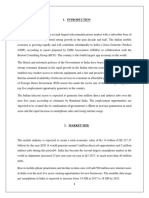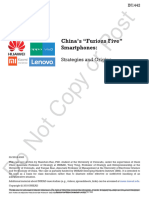Smartphone Usage in India: A Transformative
Journey Across Multiple Levels
May 25, 2025
1 Introduction
Smartphones have become integral to modern life in India, reshaping communication,
commerce, education, and personal interactions. With over 1 billion users expected by
2025, India is a global leader in smartphone adoption. This report explores the historical
evolution of smartphones in India, their global context, and their impact at national,
domestic, local, and personal levels, highlighting both opportunities and challenges.
2 Historical Evolution of Smartphones in India
The introduction of smartphones in India began in the early 2000s with devices like the
Nokia 6600, launched in 2003, which ran on the Symbian operating system and offered
advanced features like internet access and applications. BlackBerry devices also gained
traction among business users for their email and messaging capabilities. A significant
milestone was the launch of the iPhone 3G in August 2008, which introduced a touch-
based interface and app ecosystem, followed by the HTC Dream in 2009, the first Android
smartphone in India, priced at approximately Rs 30,000. These launches, coupled with
affordable devices and declining data costs, fueled rapid market growth. By 2025, India
is expected to have over 1 billion smartphone users, driven by brands like Vivo, Xiaomi,
Samsung, and Apple.
Table 1: Key Milestones in India’s Smartphone History
Year Milestone
2003 Nokia 6600 launched, one of the first smartphones in India
2008 iPhone 3G introduced by Apple
2009 HTC Dream, first Android smartphone, launched
2023 Smartphone users estimated to exceed 1 billion
2025 Projected to have over 1 billion smartphone users
1
�3 Global Context
Globally, smartphone usage has surged, with approximately 4.69 billion users in 2024,
projected to reach 6.1 billion by 2029. India is a major contributor, with over 1 billion
users expected by 2025, accounting for roughly 20% of the global total. China leads with
974.69 million users, followed by India with 659 million in 2024, and the United States
with 276.14 million. India’s rapid growth is driven by its large population, increasing
disposable incomes, and affordable data plans, positioning it as a key player in the global
digital economy.
Table 2: Top Countries by Smartphone Users (2024)
Country Users (Millions) Penetration Rate (%)
China 974.69 68.4
India 659 46.5
United States 276.14 81.6
4 National Impact
4.1 Economic Contributions
India’s smartphone market, valued at $44.15 billion in 2023, is projected to reach $88.99
billion by 2032, with a CAGR of 8.1%. The industry has created jobs in manufacturing,
retail, and digital services. Companies like Apple, Samsung, and Xiaomi have established
manufacturing plants in India, boosting local employment. The rise of e-commerce,
digital payments (e.g., UPI), and online services has significantly contributed to economic
growth, with mobile commerce accounting for 73% of e-commerce transactions.
4.2 Social and Cultural Impacts
With a smartphone penetration rate of approximately 71% in 2023, smartphones have
transformed communication, enabling instant connectivity via messaging apps and social
media. They have also democratized access to information and education, particularly
during the COVID-19 pandemic, when online learning became essential. Socially, smart-
phones have shifted consumption patterns, with consumers becoming more informed and
value-conscious, as noted by the World Economic Forum.
4.3 Market Dynamics
In Q4 2024, Vivo led the market with a 20% share, followed by Xiaomi (18.23%) and
Samsung (13.69%). Apple entered the top five with a 10% share, driven by models like
the iPhone 15. The market saw 153 million units shipped in 2024, with 5G smartphones
comprising over 55% of shipments, reflecting a shift toward advanced technology.
5 Domestic Usage
Smartphones are nearly ubiquitous in Indian households, with 88% owning at least one
mobile phone by 2016, a figure likely higher today. In many households, especially in
2
� Table 3: Smartphone Market Share in India (Q4 2024)
Brand Market Share (%)
Vivo 20
Xiaomi 18.23
Samsung 13.69
Apple 10
OPPO Not specified (high growth)
lower-income groups, smartphones are shared among family members for communication,
entertainment, and education. During the pandemic, smartphones facilitated remote
learning, with apps like YouTube and educational platforms becoming vital. However, a
2024 study by Vivo and CMR highlighted that 69% of children and 73% of parents see
smartphone overuse as a source of family conflict, indicating a need for balanced usage
to maintain healthy relationships.
6 Local Influence
Smartphone adoption varies between urban and rural areas. Urban areas have higher
penetration due to better infrastructure, but rural India is catching up rapidly. The
ASER 2023 report noted that 74.8% of rural households owned a smartphone in 2022, up
from 36% in 2018. By 2025, 56% of new internet users are expected to come from rural
areas, driven by affordable devices and data plans. Smartphones are bridging the digital
divide, enabling rural communities to access information, education, and services like
digital payments and agricultural apps. For example, farmers use apps to check weather
and market prices, enhancing productivity.
7 Personal Impact
Smartphones have profoundly changed individual lives in India across multiple domains:
• Communication: Instant messaging apps and social media have made staying con-
nected effortless.
• Education: Online courses and educational apps have expanded learning opportuni-
ties, especially in remote areas.
• Entertainment: Streaming services, gaming, and music apps provide endless enter-
tainment options.
• Financial Inclusion: Digital wallets and UPI have made financial services accessible,
with 70% of e-commerce transactions via mobile devices.
• Healthcare: Telemedicine apps enable remote consultations, improving healthcare
access.
• Productivity: Smartphones support work-related tasks through email, calendars,
3
� and apps.
However, challenges like smartphone addiction, particularly among adolescents, can im-
pact mental health and sleep patterns, necessitating awareness and moderation.
8 Challenges and Considerations
While smartphones offer numerous benefits, they also pose challenges. Excessive use can
lead to health issues like text neck and sleep disturbances. Privacy concerns arise with the
use of AI surveillance technologies, as India is among 75 countries with such capabilities.
Additionally, the digital divide persists, with gender gaps in smartphone ownership (43.7%
of males vs. 19.8% of females in rural areas own smartphones). Addressing these issues
is crucial for equitable benefits.
9 Conclusion
Smartphones have transformed India at multiple levels, from driving economic growth
and social connectivity to empowering individuals with access to information and ser-
vices. With over 1 billion users expected by 2025, Indias smartphone market is a global
powerhouse. However, balancing the benefits with challenges like addiction, privacy, and
equitable access will be key to sustaining this transformation.





















































































